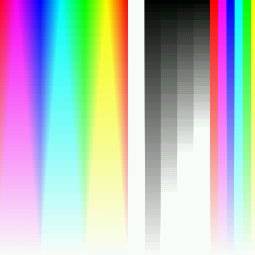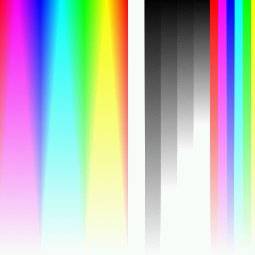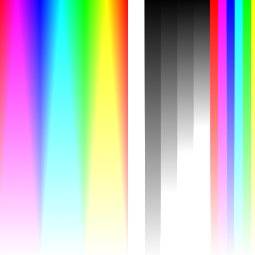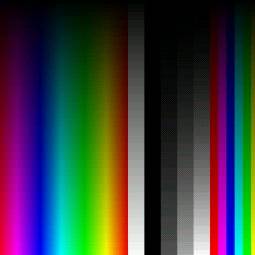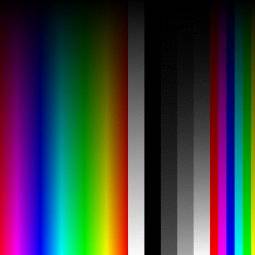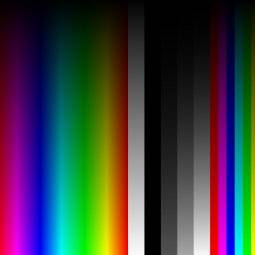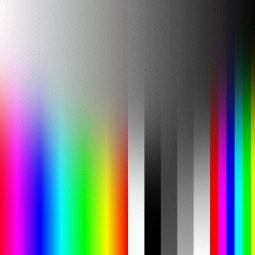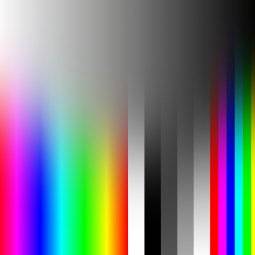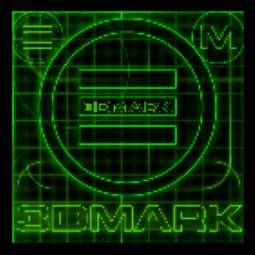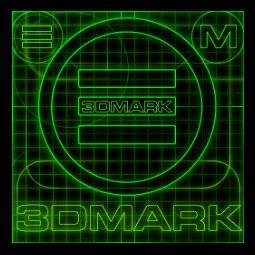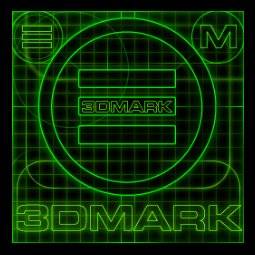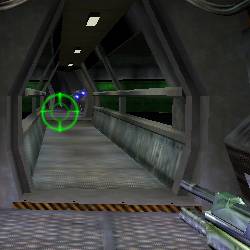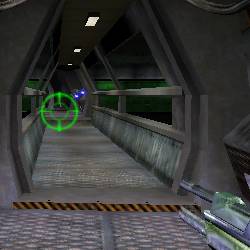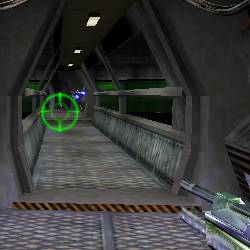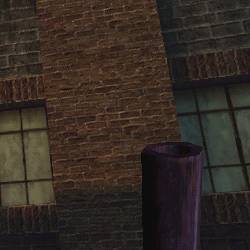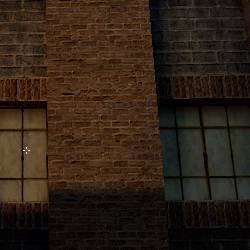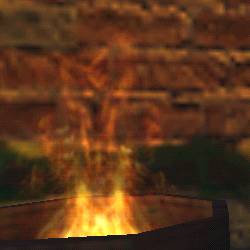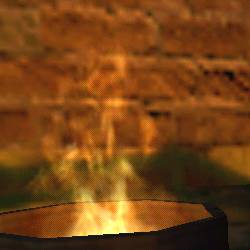
| CPU | Mainboards | Video | Storage | Multimedia | Other | Search |

3dfx Voodoo3 2000 Review
The new chipsets were called Voodoo3 and got divided into 3 types: Voodoo3 2000, Voodoo3 3000 and Voodoo3 3500 with the corresponding core and memory frequencies equal to 143, 166 and 183MHz. Remember the time when Riva TNT and Banshee were driving everyone crazy, and Voodoo2 was still pretty popular. Then people, who were so much used to frequencies varying somewhere between 90 and 110MHz, could hardly imagine that one day the frequency would reach 183MHz. But nevertheless life continued its usual course and all we could do was just to have patience and wait for this wonder to come to Russia. However, it was then that we started doubting the true practical value of this masterpiece. Of course, the speed was supposed to be rather high, especially in the latest models, but all the rest seemed to remain on almost the same level. For example, Voodoo3 image quality was expected to be very similar to that of Banshee despite 3dfx's attempts to promote the 22-bit rendering, which was supposed to give a perfect 16-bit image. And finally we also managed to get Voodoo3 2000 for a couple of benchmarks, so if you have any questions, please, address them to us and we'll try to satisfy your curiosity. But before we start we'd like to offer you a complete set of Voodoo3 2000 specs:
It can be easily noticed that the main features distinguishing Voodoo3 from Banshee are higher core and memory frequencies, 300MHz RAMDAC and multitexturing. Closing our eyes to the forthcoming benchmarks we are tempted to call it Banshee2. Why so? Well, it's very simple. About a year ago Voodoo2 chipset aroused public excitement and enthusiasm in the market of gaming 3D-accelerators, which was a great leap forward compared to Voodoo1 (Voodoo Graphics). That's why for most people the next number in the name of this device means revolutionary performance improvement, while in fact Voodoo3 is none other than an overclocked Voodoo2 with Banshee2D. Of course, 3dfx was aware of this psychological phenomenon. And in order to attract public attention this company called its new product Voodoo3 on purpose, which actually was a very successful marketing move since 3dfx is no longer the only leader in 3D gaming graphics market. Nevertheless, people very rarely happen to remain absolutely indifferent to such novelties as Voodoo3 2000 for instance, especially taking into account its relatively low price. And as for us, we were lucky to get it for benchmarking. So, let's pass over to the main point. 3dfx Voodoo3 2000 graphics card is an AGP board (PCI version will be also available) with 16MB 7ns-SDRAM.
The first thing that catches your eye is an extremely familiar board design, which looks very much like STB Velocity 4400. This observation makes us suspect that STB decided to save itself time and trouble by leaving the same outlook for its new product. Besides the chipset itself and 8 memory modules the board is also equipped with a BIOS chip and its accompanying logic. There are also free spaces for chips and TV-out connectors (as to the announcements they will be only on 3000 and 3500 models). But what makes it almost impossible to distinguish between Voodoo3 2000 and STB Velocity 4400 is a black pin radiator, set onto the chipset. Unfortunately, we can't say anything about the whole package set since we've got just an OEM-sample. The testing system included the following components:
Besides we provided the graphics card with an additional cooler, which sent the air stream directly to the graphics board radiator.
According to the achieved results the value of this parameter influences neither image quality, nor graphics card working rate.
Here you can actually see that we used the drivers version dated back to 20 March, 1999, and a miniGL-driver (OpenGL wrapper) - 1.47. Undoubtedly, many of you paid attention to primarily chipset and memory frequencies displayed on the screenshot: 174MHz (frankly speaking, it implies 175MHz). And many of you are definitely puzzled because all this seems absolutely impossible, especially when you know that the chipset is initially designed for 143MHz. And the explanation is very simple: it is a special Voodoo3 overclocking program that is to blame - Voodoo3 Overclock Property Page (by Gary Peterson). It is installed separately and creates another page in monitor settings list.
The next point. Any benchmark - even if all the values are beautifully arranged in colorful charts - is half the battle. These numbers may be of any use only to a specialist, and the common user always needs a comparative analysis with some other products, which have already been tested and studied inside out. And the present case isn't an exception. Stating that Voodoo3 is slower or faster is not enough. To make it more illustrative and hence more persuasive it should be given in comparison with the other cards. That is why we decided to take the already known benchmark results of the popular graphics cards based on the following chipsets: Nvidia Riva TNT (Creative Graphics Blaster Riva TNT), ATI Rage128 (ATI Rage Fury), and Voodoo2 SLI (Quantum3D Obsidian2 X-24). The performance of all these graphics cards approximates to that of the most novelties and their price is close to that of Voodoo3 (with the only exception of Voodoo2 SLI, which is still quite expensive). The first issue we'd like to consider deals with Voodoo3 2000 performance rate and quality in 2D-graphics. To check it we ran a popular WinBench99 and obtained the following results: 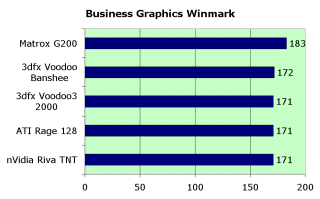 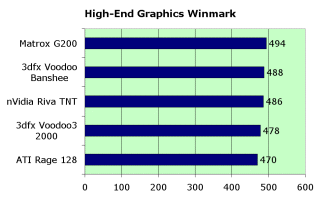 To our great disappointment we have to admit that the only noticeable improvement was a slight RAMDAC increase. As for the rest - nothing had changed there despite 3dfx's promise to improve 2D-graphics, which hasn't yet been put into practice. The results can be compared to those of Banshee, Voodoo3 2000 predecessor. However, we cannot deny that 2D-graphics quality has risen. May not so great as we wished, but with 1280x1024 resolution my eyes were quite comfortable, everything was clear-cut and distinct, and the speed visually seemed really cool. At a greater resolution 1600x1200 the picture got a bit vaguer contours, however, we should bear in mind that some monitors (mine, for example) do not nominally support the resolution over 1280x1024, and all the objects on the screen were too small. In this respect a conclusion inevitably comes to mind: there are some purely visual improvements in quality but they are relatively insignificant, and Voodoo3 speed values were somewhere on Banshee level, which is actually enough for a gaming graphics card. We are swiftly moving forward and now we finally approach the sacred 3D-kingdom. :) Let's start with quantitative values characterizing the board's performance speed. To look at it we utilized a couple of tools:
We considered Voodoo3 2000 working at two different frequency settings - at its nominal frequency 143MHz and at the overclocked frequency 175MHz. The results obtained are given below: 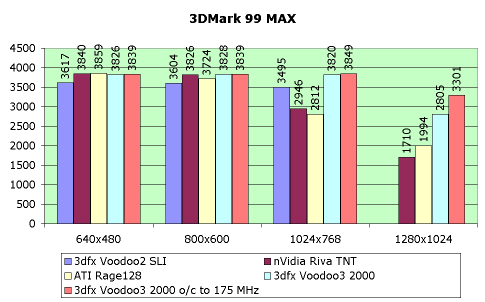 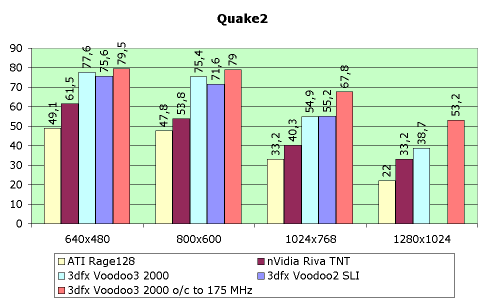 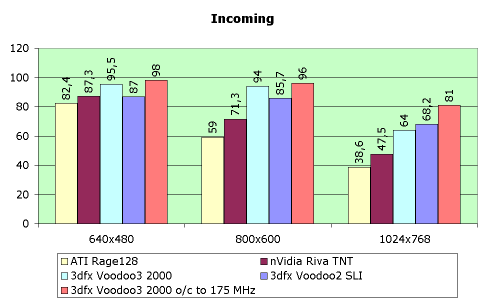
We would like to point out that all the values presented above were obtained with 16-bit color depth since it is the only color depth Voodoo3 supports in 3D. Then comes the Voodoo3 2000 performance scalability diagram: 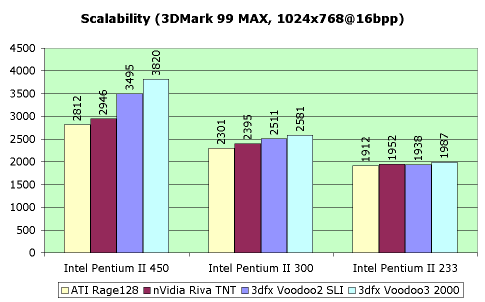 Let's discuss these results in detail. The first thing, which is worth mentioning, is the data obtained with Pentium III CPU in 3DMark 99 MAX. The video chipset was overclocked to 175MHz and the data achieved at this frequency are listed in the table below:
The speed proved to fantastically increase as soon as it came to SSE support. Unfortunately, now we can enjoy it only in benchmarks like 3DMark99 MAX and various demo-utilities because the market cannot yet boast any SSE supporting games. Then. The first and the most important conclusion sounds very discouraging: we have come a cropper! Yes, that's the bare truth! Graphics accelerators become so cool and fast that the CPUs are simply unable to keep pace with them. Have a look at the charts for 640x480 and 800x600! Super-high frequency Voodoo3 showed practically the same result as the graphics cards of the previous generation did. And only at 1024x768 the difference will become significant. What does this all mean? And it actually means that no matter what you will acquire a Voodoo2 SLI, a Riva TNT or a Voodoo3, you will also need a big monitor, so that you could enjoy all the beauty and coolness of 3D-picture at higher resolutions. A super-accelerator combined with a low resolution (640x480, for instance) will be just a waste of money and absolutely no satisfaction. In other words, while most cool processors, which provide a significantly higher graphics card performance, are still too expensive, purchasing a new accelerator will make sense only if you have a 17" monitor (or even bigger). However, it should be noted that OpenGL shows a bit different picture. Voodoo3 2000 speed gain appears significant at 640x480 as well, which is clearly displayed in Quake2. And in addition the scalability diagram above beautifully demonstrates the limitation imposed by CPU frequency on Voodoo3 speed increasing. Nevertheless, we simply can't disregard the Voodoo3 2000 extremely high speed especially with the processor overclocked up to 175MHz. To conclude with we'd like to share the following idea. If 3D-image quality is supposed to be on the same level for all the chipsets, then buying a Voodoo3 2000 (not to mention the graphics cards with cooler performance) will sound reasonable only with at least 400MHz processor frequency. Uh! Well, it looks as if we are through with the performance rate, and now it's high time we tackled the quality. We can competently announce that the quality is exactly the same as that by Banshee including all drawbacks, especially in terms of alpha-blending. Below you can see the outcome of three 3DMark 99 MAX tests showing different ways of alpha-blending (Riva TNT is also given for a better comparison):
These figures clearly show that banding is typical of Voodoo3 in every test and is totally absent by RivaTNT. Then we have to mention a great performance impairing as it comes to larger textures since Voodoo3 doesn't have any corresponding support:
Besides, the image quality in one of 3DMark 99 MAX gaming episodes seems worth your attention:
The screenshots of Voodoo3 performance nicely show that the latticed floor has a washed out grain outlook. Actually the blurring has become a permanent characteristics of 3dfx graphics cards because they have definitely gone too far trying to get rid of image discreteness (pixellization). And finally, take a look at a couple of screenshots of Voodoo3 OpenGL performance (Riva TNT data is also given for a better comparison). This is a game called Kingpin:
It's really hard to find any grave differences but as for us, a warmer and livelier Riva TNT picture cheers the cockles of our heart. So, the benchmarks prove that those who prefer Voodo2 or Banshee will be satisfied with Voodoo3 as well. However, there is one great drawback. You have probably noticed that we omitted the performance of Voodoo3 in Glide-games. Actually for a very commonplace reason: the terrific Unreal (the initial purely Glide-version as well as 2.20 version), the brilliant motor races Need For Speed III simply can't get started in Glide. 3dfx couldn't probably think of anything better but change Glide specification right before the launching of Voodoo3. As a result the drivers contain a new API-version, which turns out not quite compatible with the older one. And this in its turn means that we can do nothing but wait and wait for the new Glide-games patches to come out. Epic Megagames promises to improve the situation only with a new patch 2.24, Electronic Arts is still keeping silence. The situation strikes as very similar to Banshee case, doesn't it? To be fair we should say that NFSIII and Unreal 2.20 can be run in Direct3D and perform beautifully (it refers especially to Unreal, which achieved 51fps at 1024x768). However, Unreal D3D version is rich in inaccurate scene details imaging that's why a new patch will be strongly recommended (though the following remark doesn't make much sense if you haven't seen Unreal Glide). Before drawing the final conclusions we would like to say that despite 0.25 micron technology the graphics card gets very warm while working (especially while overclocking), that is why we advise you to acquire appropriate coolers, aka chip coolers, which are already available in retail. ConclusionsTaking into account Voodoo3 2000 relatively low price (it's cheaper than ATI Rage Fury, for example) we would recommend the following graphics card for powerful CPUs owners. It will be very up to date and will serve you faithfully before the market is overwhelmed by new games with 32-bit Z-buffer support, with the evident difference between 32-bit and 16-bit color, and with textures exceeding 256x256 and making use of AGP potential. Long before we got Voodoo3 for benchmarks it was already clear that this graphics card as all the 3dfx previous chipsets can't be fully with AGP. This fact was proved by 3DMark 99 MAX for larger textures, which simply exhausted Voodoo3. If you are put into a dilemma and can't decide between Voodoo2 SLI and Voodoo3 2000 we would tell you with all certainty: take Voodoo3 2000! It is almost twice as cheap as Voodoo2 SLI however the performance is on the same level (and even higher if overclocked). For those who already have a Voodoo2 and who want to buy a second one to make a SLI we would advise to sell it together with 2D-card as soon as possible and to get a Voodoo3 2000. As a result you will get a considerably good 2D and an excellent 3D-graphics. And as for Riva TNT-, or Rage128-based graphics cards owners it's hard
to find any suitable recommendation. They'd better not bargain one trouble
for another and wait for Riva TNT2 or Matrox G400 to come out. Considering
that it is about to appear pretty soon.  | ||||||||||||||||||||||||||||||||||||||||||||||||||||||||||||||||||||||||||||||||||||||||||||||||||||||||||||||||||||||||||||||||||||||||||||||||||||||||||||||||||||||||||||||||||||||||||||||||||

| CPU | Mainboards | Video | Storage | Multimedia | Other | Search |

|
|
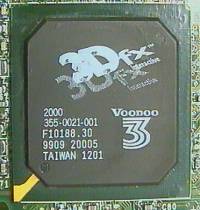 In
the beginning of this year a new graphics cards family from 3dfx
Interactive was announced. You haven't misheard: it was graphics cards
that they meant and not chipsets, as we could suppose. 3dfx became the
only manufacturer of graphics cards based on its own chips after having
merged with STB Systems.
In
the beginning of this year a new graphics cards family from 3dfx
Interactive was announced. You haven't misheard: it was graphics cards
that they meant and not chipsets, as we could suppose. 3dfx became the
only manufacturer of graphics cards based on its own chips after having
merged with STB Systems.
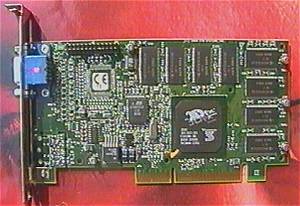
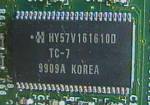
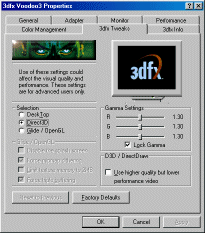 Well,
enough for that. You have probably got the general idea of this device, so
we can start looking at Voodoo3 2000 at work. First of all, a few words
about installation. The drivers are supplied on the enclosed CD-disk. They
are all packed into one single EXE-file that is why at first a Standard
VGA adapter should be installed. After unpacking and installing the
drivers, in the display properties panel appeared several additional pages
with graphics card controls. The contents of these additional pages is
similar to the well known settings of Voodoo2 or Banshee that's why we
won't dwell here (there is Vsync closing option, triple buffer and
dithering). Besides, there is also a mark, which serves to balance the
ratio between quality and quantity and which may take extreme values
(on/off), and avoid smoothing the picture (as most other graphics cards
do).
Well,
enough for that. You have probably got the general idea of this device, so
we can start looking at Voodoo3 2000 at work. First of all, a few words
about installation. The drivers are supplied on the enclosed CD-disk. They
are all packed into one single EXE-file that is why at first a Standard
VGA adapter should be installed. After unpacking and installing the
drivers, in the display properties panel appeared several additional pages
with graphics card controls. The contents of these additional pages is
similar to the well known settings of Voodoo2 or Banshee that's why we
won't dwell here (there is Vsync closing option, triple buffer and
dithering). Besides, there is also a mark, which serves to balance the
ratio between quality and quantity and which may take extreme values
(on/off), and avoid smoothing the picture (as most other graphics cards
do).
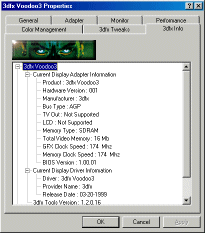 A certain
page provides us with some graphics card statistics: e.g. its type,
drivers revision, memory, etc.
A certain
page provides us with some graphics card statistics: e.g. its type,
drivers revision, memory, etc.
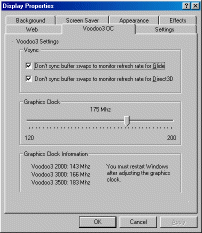 Here we
get the whole set of cool options. We may not only smoothly change Voodoo3
chip performance and memory frequency from 120MHz to 200MHz, but also
disable Vsync (monitor refresh rate synchronization with RAMDAC). After
changing the frequency, the PC should be restarted. By simply trying all
the suitable combinations we managed to find the maximal frequency -
175MHz, when the card shows a rather stable performance. It even exceeds
the nominal frequency of Voodoo3 3000 (166MHz), which is very pleasing for
all overclocking fans.
Here we
get the whole set of cool options. We may not only smoothly change Voodoo3
chip performance and memory frequency from 120MHz to 200MHz, but also
disable Vsync (monitor refresh rate synchronization with RAMDAC). After
changing the frequency, the PC should be restarted. By simply trying all
the suitable combinations we managed to find the maximal frequency -
175MHz, when the card shows a rather stable performance. It even exceeds
the nominal frequency of Voodoo3 3000 (166MHz), which is very pleasing for
all overclocking fans.
